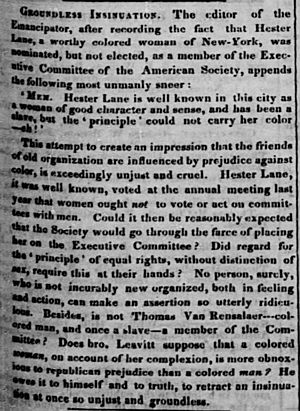Hester Lane facts for kids
Hester Lane (died 1849) was an amazing American woman who fought against slavery. She was also a successful businesswoman and helped many people. Born into slavery in Maryland, she later became a free woman and lived in New York. Hester Lane was known for her special way of painting walls, for buying freedom for enslaved people, and for a big discussion about her joining an important anti-slavery group. She passed away in July 1849 during a serious sickness called cholera.
Contents
A Smart Businesswoman
Hester Lane was a true self-made woman. She started and ran her own business as a "whitewasher," which was like being a decorator for walls. She even taught herself French! In 1830, government records showed her as a "Free Black Head of Household," meaning she was a free Black woman who was the main person in her home. A British writer named Edward Strutt Abdy met her in 1833 and said she had earned "a comfortable competency for herself," meaning she was doing very well financially.
Helping Others Find Freedom
Hester Lane not only owned her own home, but she used the money from her business to buy freedom for other enslaved people. Because she was a free Black woman, she could travel to and from the Southern states without people being suspicious. By the 1820s, she was wealthy enough to buy the freedom of at least eleven people, including whole families! Hester Lane did expect those she helped to pay her back if they could. She also stayed involved in the lives of the people she freed, even helping their children get an education.
Fighting Against Slavery
Hester Lane was very active in the fight against slavery. She helped raise money for the New York Committee of Vigilance, which was a group that worked to protect Black people and help those escaping slavery. She worked with David Ruggles to raise money for William Lloyd Garrison's newspaper, Liberator, which was a strong voice against slavery. Lane also served on the board of managers for the African Dorcas Association, a group that helped people in the New York community. She even helped organize events to raise money for churches, like the Second African Presbyterian Church in Philadelphia.
A Nomination That Caused a Stir
In May 1840, there was a big disagreement within the American Anti-Slavery Society (AASS), a major group fighting slavery. Some members left and formed a new group called the American and Foreign Anti-Slavery Society (AFASS). This change opened up more chances for women to become leaders in the AASS.
Charles Ray, whose wife was friends with Hester Lane, suggested that Lane join the executive committee of the AASS. Another member, David Lee Child, said that everyone in the society should have equal rights, no matter their gender or skin color. He said the group's actions should match its beliefs. However, the group voted against Hester Lane's nomination. Instead, they chose three white women: Maria Chapman, Lydia Maria Child, and Lucretia Mott.
This decision caused a lot of discussion. When reporting on the meeting, Charles Ray wrote in The Colored American newspaper that he believed racism was the reason for the decision. He said that Hester Lane was a respected woman with good sense, but her "color" (meaning her race) stopped her from being chosen.
However, Thomas Van Rensselaer, another African American activist who had just joined the committee, disagreed with Ray. He said that Lane's nomination was actually "withdrawn by us, rather reluctantly, by persuasion." Rensselaer explained in a letter to The Emancipator newspaper that he had talked to Mrs. Lane a few days before and found out she supported the group that had left the AASS. He felt she was against "us" (the remaining AASS members).
Historian Martha S. Jones explains that Hester Lane's story shows how anti-slavery activists debated women's rights. In this case, the idea of women's equality was overshadowed by issues of race.
False Accusations
In January 1838, Hester Lane faced a difficult time when she was investigated for serious accusations. A woman named Martha Johnson claimed that Lane had kidnapped and sold enslaved people. A group called the "Committee of Investigation" looked into these claims. It seems that Johnson and Lane had a disagreement about property that Johnson was renting from Lane.
In February 1839, the Investigative Committee announced their decision at the Ashbury Church. They found Hester Lane innocent of all the charges.
Even after she was cleared, some people still believed the false stories. They thought she had earned her money from illegal activities. There were arguments outside the police station about her innocence. A crowd of people was very angry, but an armed group of soldiers returning from their training arrived, and the crowd soon left.
On February 10, 1838, the committee published their report in The Colored American newspaper, officially announcing Hester Lane's innocence.
Later Life
After the events of 1840 and the discussion about her nomination, Hester Lane stepped back from her public anti-slavery work. She passed away in 1849 from cholera during a widespread outbreak of the disease.
Images for kids



